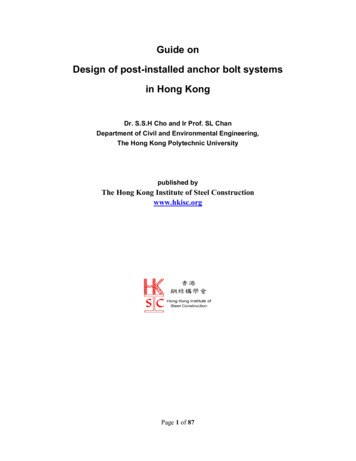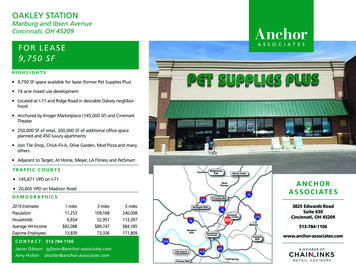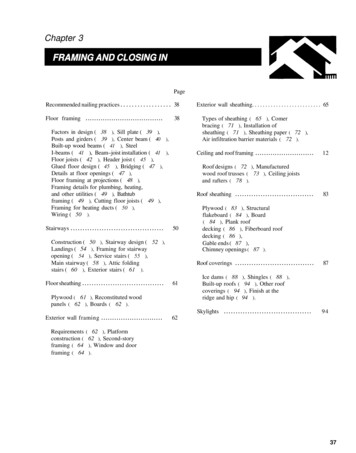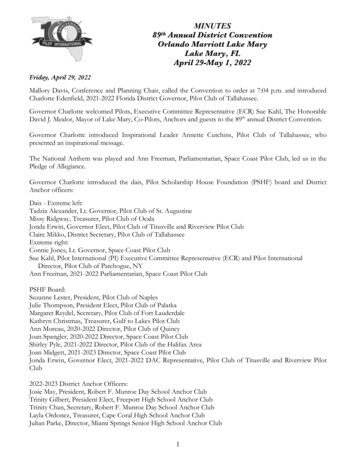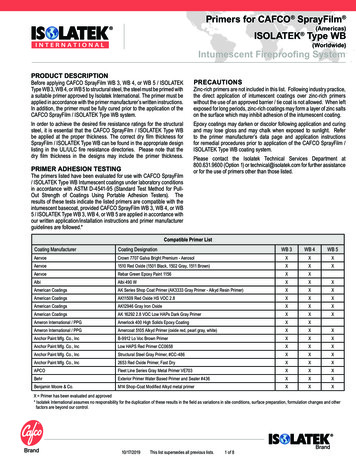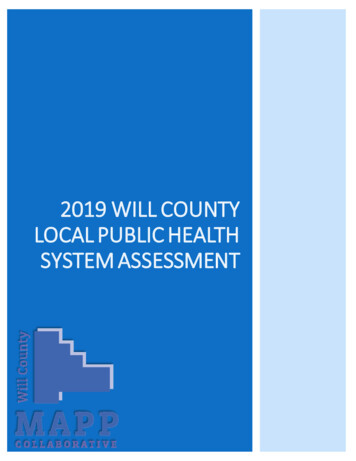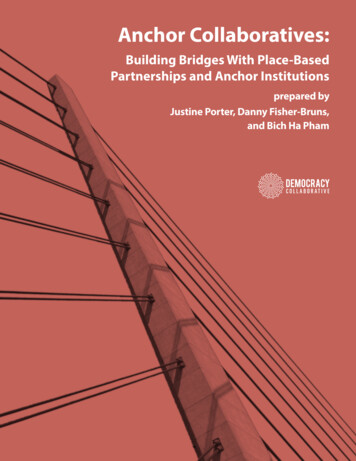
Transcription
Anchor Collaboratives:Building Bridges With Place-BasedPartnerships and Anchor Institutionsprepared byJustine Porter, Danny Fisher-Bruns,and Bich Ha Pham
2
Anchor Collaboratives:Building Bridges With Place-BasedPartnerships and Anchor Institutionsprepared byJustine Porter, Danny Fisher-Bruns,and Bich Ha Pham3
Table of ContentsIntroduction. 5Anchor Collaboratives in the US. 5What is an anchor collaborative?. 6Why are anchor collaboratives important?. 8Cities attending TDC’s national anchor collaborative convening. 9Who are the regular players at the anchor collaborative table?. 12What are the main types of backbone organizationsfor anchor collaboratives?. 13What are the common funding structures?. 26What are the common start-up phase considerationsfor anchor collaboratives? . 28Key factors for anchor collaboration. 29Conclusion. 31Resources. 32The Democracy Collaborative . 33The Anchor Collaborative Network. 33Notes. 344
IntroductionAcross the country, anchor institutions are beginning to understand and leveragethe power of their economic assets to address social and economic disparities andrevitalize local communities. Because of their commitment to place and their economic power, anchor institutions are uniquely positioned to stabilize local economies and begin to reverse the devastating effects of urban disinvestment.An increasing number of anchor institutions and partner organizations have joinedto form place-based networks, or anchor collaboratives, to develop, implement, andsupport shared goals and initiatives that advance equitable and inclusive economicdevelopment strategies. The challenges our cities and communities face today aredaunting. But when anchor institutions intentionally align their collective resources for stronger and more inclusive economies and healthier communities, they canmake real change happen locally. The anchor mission work also helps these institutions to see themselves as threads of the social fabric of their community—and theybegin to view their role as a part of the solution in bolder and broader ways.In January 2019, the Anchor Collaborative Network (ACN) was initiated to build ashared movement of anchor institution collaborations that are working to accelerate equitable, inclusive strategies that respond to local needs and challenges. Thisreport presents information and examples to show the current state of the field.ACN Working Groups plan to produce case studies, toolkits and other educationalinformation to further assist other cities, anchor institutions, and partner organizations to learn about and advance anchor mission work.ANCHOR COLLABORATIVES IN THE US5
What is an anchor collaborative?Anchor collaboratives strengthen local economic ecosystems bymore intentionally aligning and leveraging the significant everyday business activities of local anchor institutions in local hiringand purchasing, place-based investing and community wealthbuilding practices to create jobs, increase incomes, build community/local/broadly held wealth, and spur community investmentsto redress systemic inequities.Anchor institutions are nonprofit or public place-based entitiessuch as universities and hospitals that are rooted in their localcommunity by mission, invested capital, or relationships to customers, employees, residents and vendors.1 Anchor institutionshave an ability to engage in long term-planning in a manner thataligns their institutional interests with those of their local communities. They have both ability and motivation to play a keyrole in improving the long-term wellbeing of the communitiesthey serve by better aligning and deploying their institutional resources—such as hiring, purchasing, and investment—with theneeds of those communities.Health systems and universities together have expenditures ofmore than 1 trillion annually, have at least 750 billion in investment assets, and employ more than 9 million people.2 These community institutions are often the largest employers and purchasers in many lower-income communities where they are situated.They are also potential investors in these communities wheretheir patients and students live, supporting with affordable housing, promoting home ownership, creating employee-owned businesses and more.6
An increasing number of anchor institutions have joined together to form anchor collaboratives. Anchor collaboratives can takemany forms, but generally consist of a network of place-basedanchor institutions that join together to develop, implement, andsupport shared goals and initiatives that advance equitable andinclusive economic development strategies. Through collaboratives, anchors can share best practices, collaborate, and plan interventions that accelerate their shared goals.Community wealth building is a systems approach to economicdevelopment that creates an inclusive, sustainable economy builton locally rooted and broadly held ownership. This frameworkcalls for developing place-based assets of many kinds, workingcollaboratively, tapping large sources of demand, and fosteringeconomic institutions and ecosystems of support for enterprisesrooted in community. The aim is to create a new system that enables inclusive enterprises and communities to thrive and helpsfamilies increase economic security.3Some anchor collaboratives are actively working to advance community wealth building, while others approach this work throughan economic development lens. Sometimes collaboratives beginwith the explicit purpose of helping anchors aggregate their localeconomic power and scale up local hiring, purchasing or investing efforts. Other times collaboratives begin with local or regional goals around equity and inclusion, or local economy and bringanchors to the table as part of their broader strategy to reachthose goals. Whatever the starting point, anchor institutions andpartner organizations in the collaborative must build alignmentaround a shared vision. The groups are not just “buying into” or“agreeing to” the vision but are co-creating it.7
Why are anchor collaborativesimportant?Anchor institutions are key to unlocking “sticky capital.” Unlike corporationsthat often come and go from communities, anchor institutions are unlikelyto relocate because they are committed to place by their mission, customerrelationships, investments, property and land holdings. This often meansthat they are committed to operating in a community long term and havegreater incentives to ensure a thriving and vital community.Anchor collaboratives are able to scale up the economic impact of anchorinstitutions by leveraging their unified power through hiring, contract procurement, and place-based investments.Many disadvantaged and disinvested neighborhoods that experience high unemployAnchor collaboratives areable to scale up the economic ment, a lack of good-paying jobs, insufficientimpact of anchor institutions support for small local businesses, and littleaccess to financial capital and resources are ofby leveraging their unifiedten unable to connect to the resources of theirpower through hiring,local economic engines. Anchor collaborativescontract procurement, andbring together large employers—often healthplace-based investments.care and higher education institutions—alongwith local organizations and residents to identify, design, and improve the economic ecosystem so that local residents andbusinesses can tap into needed resources over the long term. Even anchorcollaborative members who are not located directly in the low-income communities can have a positive impact if they work intentionally to supportthe economic stability and equitable economic development of the neighborhoods, such as through purchasing from locally owned or employee-ownedbusinesses.Collaboratives also provide the advantages of a broader breadth of purchasing types, different size budgets (big institutions and small institutions), varied types of jobs and hiring needs, and a chance to scale intermediary strategies (e.g., one institution may not be sufficient to scale a training programor purchasing strategy).8
Cities attending TDC’s national anchorcollaborative conveningCity-based or regional anchor collaboratives exist in many different communitiesand serve various functions. Many more cities and regions are exploring formingan anchor collaborative or layering an anchor collaborative strategy into existingcommunity wealth building or economic inclusion initiatives. There are also citiesor regions that have partnerships that fit the definition of an anchor collaborativebut call it something else, such as a coalition economic development project. Insome cases, local nonprofit or community organizations decide to adopt an anchorcollaborative strategy to advance their mission.In 2017, The Democracy Collaborative (TDC) surveyed more than 40 anchor collaboratives and community partnerships to inform our inaugural national convening. We found that these cities shared common successes as well as sharedchallenges at each level of the work. The attendees at TDC’s first anchor collaborative national convening held in June 2018 included:Atlanta, GeorgiaPhiladelphia, PennsylvaniaAugusta, GeorgiaPittsburgh, PennsylvaniaAlbuquerque, New MexicoPoughkeepsie, New YorkBaltimore, MarylandPreston, EnglandBoston, MassachusettsProvidence, Rhode IslandBuffalo, New YorkRoanoke, VirginiaCleveland, OhioRichmond, VirginiaDenver, ColoradoRochester, New YorkHouston, TexasSouth Florida (Miami-Dade & BrowardCounties)Milwaukee, WisconsinTacoma, WashingtonMemphis, TennesseeToledo, OhioNewark, New JerseyNew Orleans, LouisianaTwin Cities (St. Paul and Minneapolis),MinnesotaNew York City, New YorkWashington, D.C.Northern VirginiaToronto, Ontario in Canada9
Anchor institutions as a driver forcommunity developmentAcross the country, anchor institutions are beginning to understand and leverage the power of their economic assets to addresssocial and economic disparities and revitalize local communities.Because of their commitment to place and their economic power, anchor institutions are uniquely positioned to stabilize localeconomies and begin to reverse the devastating effects of community disinvestment.What is an anchor collaborative strategy?While anchor institutions around the country, and internationally, are beginning to adopt an anchor mission approach to theirwork, a growing number of cities and regions are taking a collaborative approach in which anchor institutions increase theirimpact and their effectiveness by pursuing shared goals.Cleveland, Ohio. Within the Greater University Circle area, institutions have elected to both adopt individual anchor strategies with their institutions and work collaboratively to addressstark economic disparities in adjacent neighborhoods. One resultof this collaboration was the launch of the Evergreen Cooperatives, worker-owned businesses that meet anchor institutionsupply-chain needs.10
Rochester, New York. Under the leadership of Mayor LovelyWarren, the City of Rochester helped launch the city’s Office ofCommunity Wealth Building and a nonprofit cooperative business development corporation, OWN Rochester. Together, theseorganizations are working to create jobs and build wealth inlow-income communities through connections to anchor institution demand.Preston, England. Preston has launched a comprehensive economic development model that incorporates public energy, public pension funds, financial institutions, and anchor institutions.Within this framework, anchor institutions and local government are working to leverage their procurement power to support locally owned businesses and cooperatives.Albuquerque, New Mexico. Healthy Neighborhoods Albuquerque’s first collaborative initiative focused on sourcing local produce. HNA is now exploring workforce development programsto support local residents.Who are the regular players at theanchor collaborative table?11
Who are the regular players at theanchor collaborative table?Anchor collaboratives are comprised mainly of anchor institutions andpartner organizations that share the vision and mission of building community wealth and cultivating an inclusive economic ecosystem in low-incomeneighborhoods. The most common anchor collaborative members are: Backbone organizations – serving as a trusted third-party convener Anchor institutions (hospitals, higher education institutions, school districts, arts institutions, libraries, museums, airports, public and privateutilities) Philanthropy Local nonprofit organizations working to address economic issues (e.g.,food, housing and community and economic development groups) Community, member and faith-based groups Municipal governmentsSome anchor collaboratives include other types of members, including: Local business representation (e.g., local chamber of commerce) Trade organizations representing key interests (e.g., Minority and Women Owned Business Enterprises (MWBE) associations) Nonprofit employment and training providers Financial entities (e.g., community development financial institutions) Local or national intermediary organizations State representatives12
What are the main types ofbackbone organizations for anchorcollaboratives?The makeup and work of anchor collaboratives vary widely in their shape,scope, and size because they are tailored to each community’s uniquestrengths and needs. Nonetheless, the role of a trusted third-party convening or backbone organization is vital to building a supportive structure ofcollaboration that will move the work forward. A backbone organizationserves to coordinate the work of the anchor collaboraThe role of a trustedtive and works to ensure consistent and open commuthird-party conveningnication of all key internal and external stakeholders.or backboneHowever, it is key that the backbone organization doesorganization isnot just accommodate the agenda of the collaborativebut also needs to push the moral imperative and visionvital to building aof community wealth building.supportive structureof collaboration thatAnchor collaboratives have formed around severalwill move the worktypes of convening or backbone organizations, such asforward.foundations, local governments, and nonprofit organizations. A consistent reason that anchor collaboratives struggle or fail tosuccessfully launch shared initiatives is a lack of a well-resourced and independent backbone organization.Foundations as convener or backbone organizationFunders, including health, private, and community foundations, often playa critical role in launching, housing, funding, and coordinating anchor collaboratives, particularly in the early launch stages. In many communities,funders play the “essential role of helping level the playing field and create a fertile environment for relationship building. Sometimes this is donein partnership with a local or national intermediary.”4 This is particularlytrue with community foundations who play the role of identifying and addressing gaps and underlying needs in their local ecosystems, including howgroups can partner to leverage their impact and identify what data is needed. Community foundations also tend to focus on assessing impact, which is13
important to anchor collaboratives given the varied stakeholders involvedand oftentimes multiple approaches and goals.Philanthropy’s involvement is generally as a funder of the anchor collaborative backbone and a participant as an anchor institution, not as a funderof the participating institutions separately.Funders, including health,In fact, local funders generally want the inprivate, and communitystitutions to bring their own resources andfunding to the partnership effort and havefoundations, often play amore incentive to provide additional fundingcritical role in launching,when anchor institutions contribute to thehousing, funding, andcost of the collaborative. Funders generallycoordinating anchorlook to raise and contribute funds to initiallycollaboratives, particularlylaunch the collaborative as well as strategiesin the early launch stages.that fill the gap between where the community is and where the economic opportunities are for supporting strategic workforce, small business or reinvestmentstrategies.5Some foundations serve as the convening or backbone organization.The Association of Baltimore Area Grantmakers (ABAG) is one illustrationof a collaborative that has philanthropic roots. ABAG is a membership organization of family and corporate philanthropies from Baltimore and thestate of Maryland. ABAG serves the role of the neutral convener for Baltimore’s anchor institutions through the Baltimore Integration Partnership(BIP). BIP was initiated through the Living Cities Integration Initiative thatinvolved several key Baltimore institutions including The Annie E. CaseyFoundation and ABAG.6ABAG had the credibility to bring a wide variety of stakeholders togetherwhen the initiative launched in 2011 focused on workforce, capital and anchor strategies. As the anchor agenda took hold, the number of institutionalpartners grew from two to now 14 working alongside public, philanthropic,14
nonprofit and community based partners. Over 40 organizations are partof the BIP Board and Workgroups.7 In addition to financial support for operations, the funders have provided information on best practices and newresearch, and connection to a national network of resources.8 The list ofBIP’s results is impressive. All 14 anchor institutions have new economicinclusion practices, programs and community-focused initiatives. The organization has helped start four new business development programs, a social enterprise, a job training program, and a wide variety of communityreinvestment projects fostered through a community development financialinstitution (CDFI) partner.9Today the ABAG work with the BIP partners remains strong. ABAG continues to coordinate the collaborative and is working on the next phase forthe partnership. ABAG maintains active relationships with the 14 anchorinstitutions that are part of the Governance Board. Another institution isalso involved in the work as well as a large business that is involved in a substantial community development project. Twelve of the anchor institutionshave set their own institutions’ goals (i.e., local purchasing, hiring and reinvestment). The BIP reports that local hiring from a subset of the institutionsthat provided data reached more than 1,000 individuals per year. Hiringthrough targeted strategies such as workforce partnerships reached morethan 400 individuals.10Kurt Sommer, Director of the BIP, stresses that for any collaborative to besuccessful, anchor institutions need to be really bought into the work andthat proposed strategies need to consider both the demand-side approachesas well as the supply-side dynamics. Also, a neutral convener can help findthe right balance between branding the collaboration and visibility for thepartner organizations’ work. It’s important for the institutions and implementing partners to get the credit since they are the ones doing and ultimately owning the work.1115
Community members gather for “Party on the Plaza” at the intersection of Marshal andMonroe in the Memphis Medical District, one of many public spaces being redesigned andactivated through MMDC’s work.The Memphis Medical District Collaborative (MMDC) serves as another example of the convening role of funders. MMDC’s launch in 2016 was builton nearly two years of intentional collaboration and groundwork initiatedby the Hyde Family Foundation (HFF) and other local foundations. Therehad previously been various efforts to revitalize the city’s Medical Districtarea, but insufficient coordination and resources hindered progress. HFFengaged the collaboration of the Medical District’s eight major anchor institutions to study the feasibility of an anchor strategy in the district. Thisresulted in a comprehensive analysis that presented a compelling case to anchor leaders for place-based economic development focus areas that couldleverage their collective impact.Ultimately HFF, along with eight anchors, committed to funding the startup of the Memphis Medical District Collaborative (MMDC), a communitydevelopment organization that now serves as the backbone in guiding andsustaining the work.12After a collaborative is launched, foundations often continue to participatein the collaborative’s working groups and initiatives as an anchor institution. It is important to note that, though foundations are the catalyst of some16
anchor collaboratives, they don’t always continue to be the anchor collaborative’s backbone organization on an ongoing basis or for the long-term.In addition to being the convening or backbone organization, some foundationsare key anchor collaborative members in areas such as Denver (The DenverFoundation), Miami (Health Foundation of South Florida), Albuquerque(Albuquerque Community Foundation), Houston (The Kinder Foundation),Cleveland (The Cleveland Foundation), and northern Virginia (The Community Foundation for Northern Virginia).While foundations have played key leadership roles in anchor collaboratives and bring a lot of energy and influence, it is important to note thatthe power dynamics can change because they bring the dollars to the table.Power dynamics can also be altered by government agencies and corporations that fund the anchor collaborative effort or have authority. Becauseof these power structures, having a trusted, neutral convener who has therespect of all parties involved is key to the success of a collaborative. Foundations and cities can play the convening role when they have the trust ofthe community and institutions.Local government as convener or backboneorganizationCity governments are also key players in many place-based anchor collaboratives. Sometimes they are the inspiration or catalyst for the collaborative,sometimes they serve as the backbone, and other times they participate asan anchor institution.The City of Rochester, New York provides an excellent model of this leadership at both the mayoral and city council levels. Mayor Lovely Warrensought new models for equitable economic development to address thecity’s growing poverty and inequality. The city faced daunting economic challenges caused by rapid deindustrialization; one sign of this was that50 percent of Rochester’s children were living below the poverty line. Onemajor development was the creation of the Rochester Office of CommunityWealth Building (OCWB) by Mayor Warren in January 2018.17
The mission of the Office of Community Wealth Building is to facilitatecross-sector collaboration between government, non-profits, the privatesector, anchor institutions, and the community, with the goal of advancingCommunity Wealth Building policies, programs, systems, and initiatives [emphasis added] in the Rochester community. The Office serves the diverseneeds of residents and small businesses in an equitable, culturally congruent, and sustainable manner. Supports the City of Rochester’s Vision Statement, Values andGuiding Principles, Assist residents with attaining pay equity and building personalwealth, Build and maintain a viable entrepreneurial and small business ecosystem, Support small businesses across all stages of the development lifecycle.13“Sitting in the cityspace, we’re reallyable to be not onlya collaborator buta convener of thesevarious stakeholdersbecause in essenceeveryone wants to dobusiness with the cityor do some work withthe city.”The OCWB has the benefit of not having to competewith nonprofits for grants and other resources. As Lomax R. Campbell, Director of the OCWB, explains, “Sitting in the city space, we’re really able to be not only acollaborator but a convener of these various stakeholders because in essence everyone wants to do businesswith the city or do some work with the city. But on thecon side, . . . the bureaucratic aspect of government andthe pace of which change happens presents . . . its challenges.”14 Mr. Campbell adds that, “It’s also important tobuild a broad coalition of constituency groups that aresupportive [of community wealth building] since elected leaders respond to their constituents.”15Another instance of the City of Rochester’s leadership was its role in incubating and spinning off OWN Rochester, an independent, community-based nonprofit organization. Its charge is to create jobs and build wealthin high-poverty areas of the city by developing, promoting, and supporting18
ENEROC, the first cooperative businessin the OWN Rochester network, provideshigh quality, cost-competitive energyefficiency installations and othersupport services to Rochester-areabusinesses.for-profit, employee-owned businessesthat are linked to sources of high demand. OWN Rochester has launchedtwo start-up businesses—an LED retrofitting company and a custodialbusiness—that will soon transition toworker cooperatives. The goal is to establish a portfolio of cooperatives overthe next few years. OCWB plays anintegral role with OWN Rochester byhaving representation on their Boardof Directors and providing an array ofdirect support services and resourcesto OWN’s management team and cooperatives.The City of Tacoma, Washington also serves as a good case of municipalleadership with its Tacoma Anchor Collaborative. After the development ofits 2025 strategic plan, Tacoma City Councilmember Anders Ibsen was interested in anchor institution engagement in achieving the community’s goalsand priorities. This led to further learnings and eventually to the formationof the Tacoma Anchor Collaborative. In addition to theCity of Tacoma, the Anchor Partners include MultiCare“I think it’s importantHealth Systems, CHI Franciscan Health, University ofin government if youPuget Sound, University of Washington-Tacoma, Bateswant something toTechnical College, Tacoma Community College, Tacomareally stick, you have toPublic Schools, Tacoma Housing Authority, and GreaterTacoma Community Foundation.16find someone who willreally shepherd it to aTanisha Jumper, Director of Media and Communicapoint that it becomestions with the City of Tacoma, stresses that the workinstitutionalized.”of the anchor collaborative is more sustainable in thelong term if the local government can figure out how toalign its work with community needs. “I think it’s important in governmentif you want something to really stick, you have to find someone who willreally shepherd it to a point that it becomes institutionalized.”17 In Tacoma,19
Councilmember Ibsen, who started the project, has made it a goal during hislast year in office to institutionalize the work to ensure its continuity. Thiswas largely done through tying the community wealth building goals to thecity’s strategic plan and having the city staff in place to work on the project.18Ms. Jumper adds, “If you want to persuade your local government to adoptcommunity wealth building goals, you need to approach government officesready to explain how this work helps them to accomplish the city’s goals . . . In addition to aligning these . . . with the direction the mayor or city council wants to take the city, it’s important to have data evidence showing thatCWB initiatives have impact, such as examples from Cleveland and othercities.”19Nonprofits as convener or backbone organizationNonprofit organizations play a prominent role in most antipoverty and community development work; they play similar key roles as backbone organizations for collaboratives in cities. Models include Newark, N.J. and Washington, D.C. Nonprofit backbone organizations often are the collaborative’sfiscal sponsor, initially staffing the effort, and leading the project planningprocess.Newark, New Jersey is a good illustration of this. It is the largest city in thestate and faces some of the state’s highest poverty and crime rates. In 2006,Newark launched its strategic plan, OpportunityNewark, to increase thecity’s competitiveness, stimulate business development, and connect residents to job opportunities by removing barriers to employment such as byproviding training and job-related expenses.In 2018 the Newark Alliance, a nonprofit dedicated to the ongoing economic revitalization of Newark, launched the Newark Anchor Collaborative(NAC) to further grow economic opportunities and wellbeing for the city.Participating institutions have committed to supporting the City’s Hire.Buy.Live initiative to advance equitable and inclusive economic developmentstrategies in Newark. NAC provides a platform for managing city-wide anchor collaborative efforts, planning for interventions, and programs to fuelgrowth. NAC’s founding institutions include RWJBarnabas, New Jersey20 pag
an anchor collaborative or layering an anchor collaborative strategy into existing community wealth building or economic inclusion initiatives. There are also cities or regions that have partnerships that fit the definition of an anchor collaborative but call it something else, such as a coalition economic development project. In

